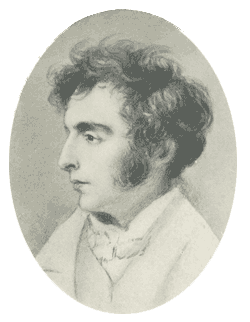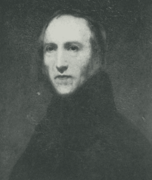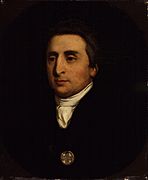Edward Daniel Leahy facts for kids
Quick facts for kids
Edward Daniel Leahy
|
|
|---|---|

Edward Daniel Leahy by J. P. Davis, 1830.
|
|
| Born | 1797 |
| Died | 9 February 1875 |
| Nationality | Irish |
| Other names | E. D. Leahy |
| Occupation | Painter |
Edward Daniel Leahy (born 1797 – died 9 February 1875) was a talented Irish painter. He was known for his portraits of people and his paintings that told stories. He started his art career in Dublin, Ireland. Later, he moved to London, England, where he became a well-known artist.
Biography
Edward Daniel Leahy's exact birthplace is a bit unclear. Some records say he was born in London. Others, like a newspaper from the 1840s, called him a "Cork man." His family was originally from Cork, Ireland.
Early Life and Training
Leahy studied art at the Dublin Society's School. He won several art prizes there between 1811 and 1814. In 1815, he showed two portraits at an art exhibition in Dublin. One of these was a painting of himself.
In 1816, he showed four more portraits, including another self-portrait. He won an award from the Irish Institute for his work. He continued to exhibit his paintings in Dublin in 1817. Soon after, he decided to move to London.
Moving to London
Leahy moved to London to become a professional artist. He specialized in painting portraits and historical scenes. In 1820, he showed his first painting at the Royal Academy in London. It was a portrait of an actress named Mrs. Yates.
He often showed his paintings at the Royal Academy and the British Institution. Many important people asked him to paint their portraits. These included Prince Augustus Frederick, Duke of Sussex and the Marquess of Bristol. He also painted famous Irish figures.
Famous Paintings
Leahy painted many historical scenes. Some of his well-known works include The Battle of the Nile and The Battle of Trafalgar, both from 1825. He also painted Mary Stuart's Farewell to France in 1826. This painting was so popular it was later made into an engraving.
Other famous paintings include Jacques and the Wounded Stag (1830). He also painted Escape of Mary Queen of Scots from Loch Leven Castle in 1837. This painting was made for a nobleman named Lord Egremont. In 1844, he painted Lady Jane Grey summoned to Execution.
After a famous painter named William Owen died in 1825, Leahy helped finish many of Owen's unfinished portraits.
Later Years
Even after moving to England, Leahy still showed his art in Dublin sometimes. He did this until 1846. In 1842, his painting Mary Queen of Scots' Farewell to France was bought by the Royal Irish Art Union.
During a visit to Cork in 1846, Leahy painted a portrait of Father Mathew. Father Mathew was known as the "Apostle of Temperance" for his work against alcohol. This portrait is now in the National Portrait Gallery, London.
Between 1837 and 1843, Leahy lived in Italy. While in Rome, he painted a portrait of the sculptor John Gibson. After returning to England, he showed a few paintings inspired by Italy. He exhibited his last painting at the Royal Academy in 1863. Edward Daniel Leahy passed away in Brighton on 9 February 1875.
Gallery
-
The Marriage at Cana (after Paolo Veronese)






